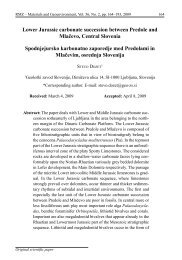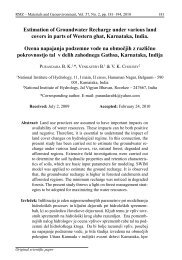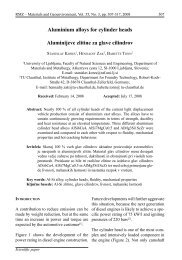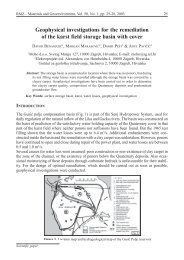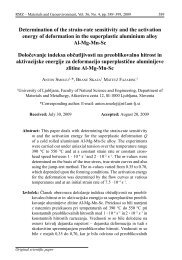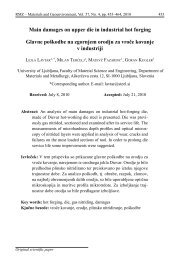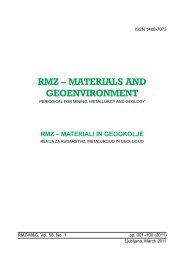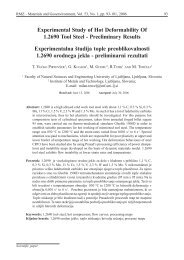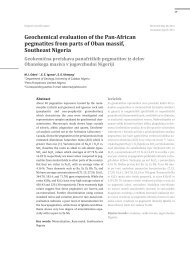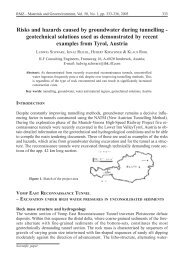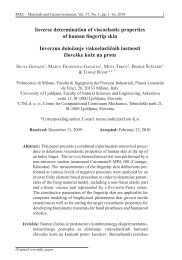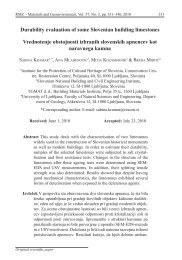RMZ â MATERIALI IN GEOOKOLJE
RMZ â MATERIALI IN GEOOKOLJE
RMZ â MATERIALI IN GEOOKOLJE
- No tags were found...
You also want an ePaper? Increase the reach of your titles
YUMPU automatically turns print PDFs into web optimized ePapers that Google loves.
358 Akinola, O. O., Talabi, A. O.values are lower than quartzite (6.54%), epidiorite (4.04 %), and calcgneiss(15.15 %). Mean Na 2O valueof migmatite gneiss (3.32 %) and biotitegneiss (3.00 %) are comparable.These values are higher than epidiorite(1.97 %) and pegmatite (2.38 %).While calc gneiss (1.08 %), quartzite(1.21 %) and amphibole schist (1.34%) are within similar range. Averagepotash content of pegmatite (6.77 %)is higher than the comparable valuefor migmatite gneiss (4.18 %) andbiotite schist (4.08 %) while lowermean values are recorded for biotitegneiss (3.86 %), quartzite (1.96 %)and amphibole schist (1.70 %). Otheroxides, TiO 2and P 2O 5do not followany discernible pattern and their valuesare generally less than 0.5 % in allthe basement rocks. Loss on Ignitionvalues are generally low and fall between1.07 % in pegmatite and 5.27 %in biotite schist.Physical and mechanical featuresThe result of the physical tests (Table 3)shows that amphibole schist has the lowestspecific gravity value of 2.54 g/cm 3while biotite gneiss has the higher valueof 2.85 g/cm 3 . Compressive strengthvalues fall within a wide range withamphibole schist having the least value(32.4 N/mm 2 ) and Granite the highestvalue (84.5 N/mm 2 ). Lowest wet densitywas obtained for amphibole schist(2.01 g/cm 3 ) and highest for migmatitegneiss (2.31 g/cm 3 ), Water Absorptioncapacity values are generally low andquartzite records the lowest (0.04 %)while amphibole schist (0.28 %) recordsthe highest. Biotite gneiss andquartzite record the lowest bulk porosityvalue of 0.01 % while the highestvalue (0.58 %) was in biotite schist. ThepH values range generally between 6.7and 7.4 with the least and highest valuein migmatite gneiss/granite and biotiteschist respectively.Industrial assessmentPhysical tests on the basement rocksare to ascertain their usefulness asbuilding materials. Building stonesdenote pieces of rock that may undergocutting, sawing, shaping andsometimes polishing and still be usefulfor construction purpose. The mainrequirements for building stones arestrength, durability, workability, andavailability. To be useful for constructionpurpose, a minimum compressivestrength of 36 N/mm 2 (367.2 kg/cm 2 ) isrequired (ASTM, 1970). Many of theBasement rock including migmatitegneisses, biotite gneiss, calc gneiss,quartzite and granite meets the abovespecification (Table 3).However, the schistose rocks have lowercompressive strengths due to theirfissility. Although, pegmatite meetsthe minimum strength requirement foruse as building stone, its large-sizedparticles are a disadvantage. Migmatiteand biotite gneiss are highly meta-<strong>RMZ</strong>-M&G 2012, 59



